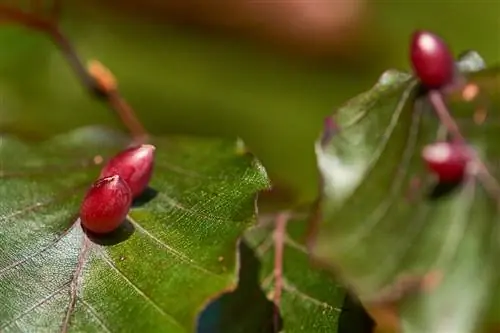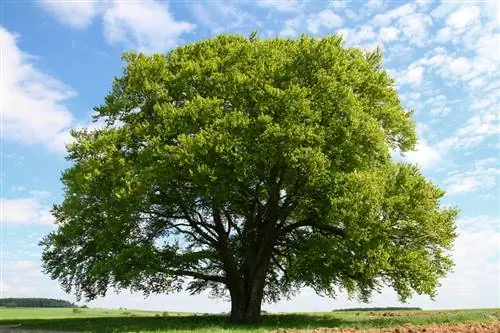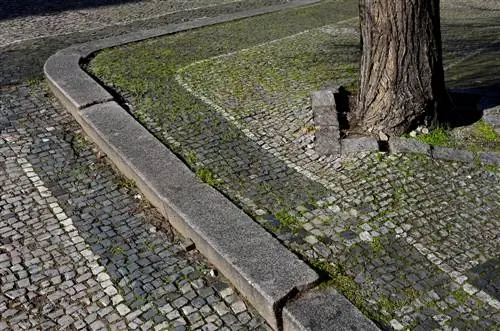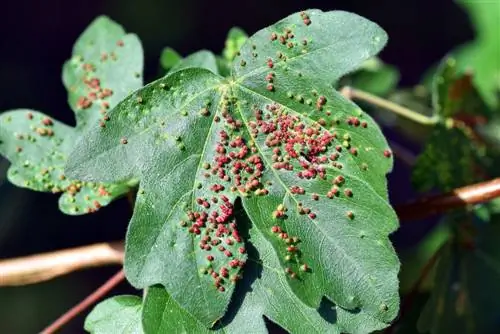- Author admin [email protected].
- Public 2023-12-16 16:46.
- Last modified 2025-01-23 11:22.
The beech hedge doesn't look the way it should. Its leaves are green, but there are small growths here and there. There is no disease behind it, but a parasite. Find out which one it is below.
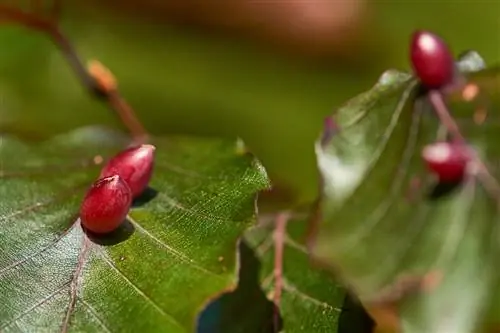
Do gall wasps appear on beech trees?
Gall waspsnotusually appear on beech trees, but growths on the leaves are the galls caused by the sucking activity of the larvae of thebeech gall midge This insect hardly harms the beech tree and therefore does not need to be eliminated.
Do gall wasps like beeches?
NormallylikeGall waspsno beeches, but prefer other deciduous trees and herbaceous plants as host plants. For example, there are the oak lens gall wasp and the sponge gall wasp, which like to find themselves on oak trees. The rose gall wasp, on the other hand, specializes in rose plants. A gall wasp infestation on maple trees can also be observed from time to time. But beech trees are fine and are more likely to be attacked by other insects.
Which pest on the beech tree is similar to the gall wasp?
It is the gall midge, more precisely theBeech gall midge (Mikiola fagi), which looks vaguely similar to the gall wasp and causes comparable symptoms. She lays her eggs on the leaf buds or the underside of the leaves of the beech tree. When the larvae hatch, they feed on the sap in the beech leaves. Galls form due to their sucking activity.
How do I recognize an infestation on the beech tree?
You can recognize an infestation by the gall midge by the egg-shapedgrowthson thetop of the leafand thediscolorationson theunderside of the leaf The larvae are 2 to 3 mm long and whitish. They are enveloped by the proliferating leaf tissue of the beech tree and can stay inside like a protected cocoon. Next spring the larvae pupate and later hatch.
Does the beech tree suffer from gall midge infestation?
A herbivorous gall midge species such as the beech leaf gall midge makes the leaves look unsightly, but thebeech does not suffer significantly from this. Therefore, such an infestation is relatively harmless. If it is a predatory gall midge species, it even supports the beech tree in the fight against pests. Their larvae eat pests such as spider mites and aphids on a beech hedge.
Should gall midges be controlled on beech trees?
Gall midges on beech trees mustnot be controlled as they do not particularly weaken a beech tree. If you want to remove the insects, you must pick and dispose of the affected leaves. It is not worth resorting to chemical agents as they harm the environment and the beech tree also grows well with the colonized leaves.
Can gall wasps that infest beech trees sting?
If gall wasps actually infest your beech tree or have laid their eggs there, you don't need to worry because theycannot sting. They are therefore not dangerous for people or pets.
Tip
Fighting insects is not recommended
The beech gall midges usually start laying their eggs during or shortly after the beech tree sprouts. If you have the beech tree under observation at this time, you can observe this spectacle. However, it is recommended not to fight these insects, as they are helpful against aphids and the like.

